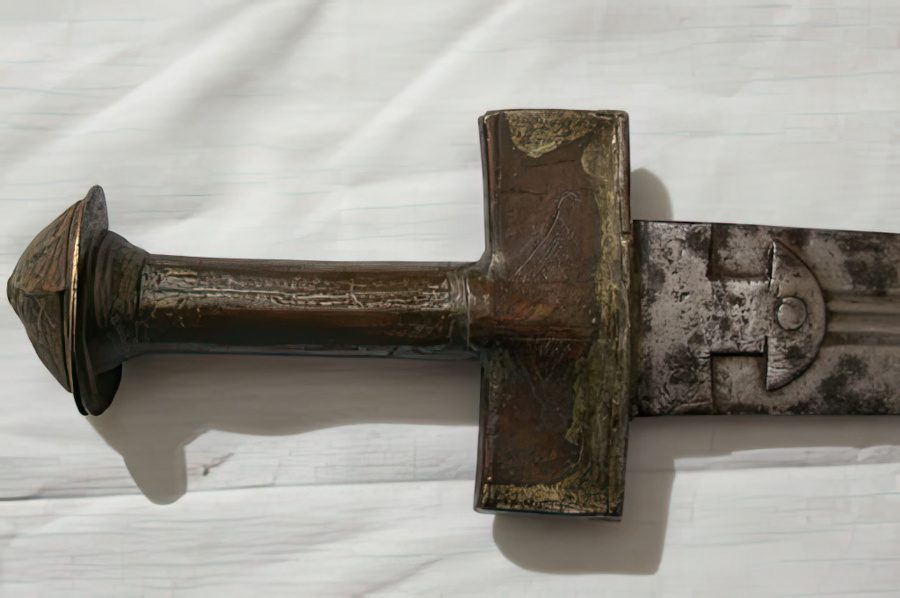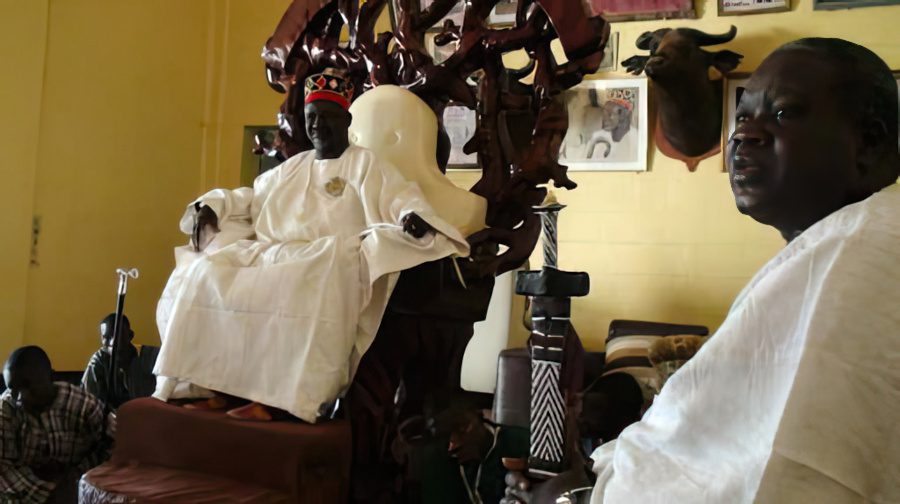Takouba Sword: The African Sub-Saharan Knightly Blade
NO AI USED This Article has been written and edited by our team with no help of the AI

Swords coming out from the African continent are known for their unorthodox looks and terrifying blades that are unlike any other type of bladed-edged weapons. Some African swords are very familiar and were used during the same time frame as those used by European knights.
The African sub-saharan blade that resembles the European arming sword is called the Takouba. This article will cover everything you need to know about this fascinating blade. We will start with its traits and characteristics and describe how it can best be used. Then we will cover the legends surrounding the Takouba and its history.
Types of Takouba Swords

The Takouba sword is seen as an individual sword by some, but by others as a form of a sword that can take many different shapes used throughout sub-Saharan Africa. Here are some of the most popular forms and diverse Takouba swords.
- Hausa (or Nupe)
- Nupe
- Lobi
- Tuareg
- Mandinka
- Fulani
- Bornu
- Mossi
The most common name and shape for the Takouba sword is the Tuareg, but it is far more than just this form. The Takouba blades were quite different based on various regions, no doubt propagated by the trans-Saharan trade spanning western and central Sahel regions, where the sword was mostly used.
Although they share some traits and characteristics, mostly in the shape of the blade and guard, each of these swords has a distinctive background and was used throughout different regions of Africa.
Characteristics of the Takouba Sword

The Takouba is a cruciform-style sword often mistaken for a European sword because of its appearance. Despite that, it has some characteristics that are very different than European bladed-edged weapons, the strongest being the large and very broad crossguard.
Blade

The blade of the Takouba African sword is straight and double-edged, meaning sharpened on both sides to be used for slashing. The blade tapers from the guard to a rounded but sharpened point at the end. The most usual blade length for a Takouba sword is 29 to 33 inches (74 to 84 cm).
Takouba swords feature blade fullers, the opening lines in the blade’s center. They aren’t made for aesthetic reasons alone but serve a couple of purposes, mainly to lighten the sword’s weight. Typically, most Takoubas have three blade fullers, with the center one being the longest. However, some have five or one, which is very wide and in the center.
The first part of the blade is usually unsharpened, forming a ricasso the length of 8 to 12 inches (20 to 30 cm) from the guard. Being a sword linked with the nobility, this ricasso can be ornamented and decorated.
Guard

The strongest and most visual characteristic of the Takouba is its crossguard. Usually, the guard of the Takouba is rectangular and made to be very wide, serving as good protection for the user’s hand. But it is believed that it’s built in this manner so that the user won’t touch the metal or steel of the blade.
The Takouba’s guard can vary in shape and size, as seen on many different swords, but the most common crossguard length is 4.3 to 5.5 inches (11 to 14 cm), while the width of it is around 1.5 inches (4 cm).
Because of the aversion among the users of the Takouba and its metal, which will be discussed below, the metal guard is always covered with tooled leather or sheathed in brass or silver. The guard can also be decorated with various patterns and precious metals based on personal preference.
Handle

Takouba swords are one-handed, with the handle sized to fit exactly one hand. It is protected by the large guard on one end with the oval or hourglass pommel on the other. The most usual handle length for the Takouba sword is around 4 to 6 inches (10 to 15 cm).
From various findings, historical pictures, and archeology, the Takouba hilts can be separated into two groups.
- Southern – a very wide guard covered in brass with a thick upper rounded pommel
- Central – a leather-covered guard with a flat pommel and a pointy pyramidal tip made out of brass and copper
This one-handed handle is also covered in leather, sometimes starting from the guard and ending at the pommel. In some cases, the handle can be sheathed and covered with silver or decorative metal plates made out of brass if the sword is for ceremonial purposes and linked with the nobility.
Pommel

The pommel is the metal piece at the very begging of the handle, acting as a tool for bashing and a counterweight for the blade’s balance. The pommel is always metal on the Takouba sword and can be in an hourglass, large and oval, or sometimes a pointy pyramidal shape with stacks of metal plates around it.
The pommel holds the full-tang blade together in place, a small piece of metal extending from the blade to the pommel and through the handle for better stability and strength. Sometimes the pommel can feature a small metal stick coming out of it.
Scabbard

The scabbard is where the Takouba blades get to stay while the sword is not in use. Its purpose is to make sword carrying easier and protect it from rain or corrosion. This scabbard or sheath is mostly leather and is as long as the blade.
The Takouba scabbards usually have an embossed African pattern; on some, there are rare and precious pearls, especially if the sword is ceremonial or linked with the nobility. The upper part of the scabbard is made of metal, and in the center, there are two loops made out of leather and a bandolier from thick linen that wraps around the person carrying it.
Traditionally, the Takouba in its scabbard was carried on the waist. Still, in African cases, the bandolier was used to tie the sword around the wielder’s body and lifted above the left side of the waist. This made it easier to unsheathe the sword when using the large Ayar shield.
Weight
Despite its large guard, the Takouba are light weapons despite looking like heavier-than-usual swords. The most common weight for Takouba swords from the past is around two lbs (0.9 kg). Combined with the shorter length, it makes the Takouba a quick-wielding blade.
Size & Length
African Takouba swords are one-handed, as they aren’t terribly long. The most usual length for the Takouba sword is 31 to 39 inches (80 to 100 cm). This allows it to be used with a shield or on horseback with quick and efficient strikes.
Uses for the Takouba Sword
The Takouba sword is a one-handed weapon because of its small handle size and large hilt fittings, such as the guard and pommel. It is primarily used for cutting and slashing strikes because its rounded tip wouldn’t make it an ideal piercing or thrusting weapon. This type of rounded tip is preferred for slicing without shredding or tearing something.
The large guard might affect the overall versatility and movement of the sword, but there are ways to overcome this, such as the pistol grip. This way, a finger is placed over the guard and on top of the ricasso.
Warfare and Combat
The biggest known use of the Takouba sword in African history is warfare. It was a sword seen on most of the nobility of the Sahel region spanning various cultures and tribes. Takoubas were made of steel and were deadly when combined with a shield or placed on a mounted unit.
The movement is the biggest and most important thing about using the Takouba swords in the past. Jumping around with fast footwork was key primarily because, at times, heavy armor was not being carried by the units wielding the Takouba due to the very high temperatures of the sub-Saharan.
Ceremonial

Being a type of metal created and surrounded by various legends made the Takouba one of the most prized possessions in Sub-Saharan Africa. This led to its use in ceremonial rituals such as early African sword dancing, wedding ceremonies, gifting, binding African tribes together, decorating the sword with precious metals, and giving orders from the throne.
Weapon of Rank
The Takouba sword is almost always linked with the high nobility. Today there is a lot of discussion about whether various African vassals and nobles would have used this sword or just the Ihagaren, the Tuareg warrior aristocratic class.
Most likely, the Takouba blade would have been used by various rich tradesmen from the vast number of African tribes in the Sahel region. With that being said, it was not easy to come by, and only those of rank and power would have it in their possession unless it was taken by force.
Trade Currency

The Sahel region in Africa spans from the west to the east, where trade between north and sub-Saharan Arica took place. Takouba blades were finely designed and would get passed along this trade route and sold to Europe and the Middle East. It was a popular trade currency used to buy things from other tribes or kingdoms.
African Sword Dancing
Dancing is a traditional part of Africa, whether for rain, better harvest, better hunt, or the good luck and prosperity that might come after a certain war. This made the Takouba sword a very popular blade still in use in African sword dancing today, such as the Tuareg and Hausa sword dancing which is based on traditional fighting style.
HAMA – Historical African Martial Arts
The HAMA (historical African martial arts) preserves and continues the sword training and swordplay from African history and is the leading organization in charge of doing so. Takouba swordplay is one of the most popular styles of African fighting.
Takouba is a popular sword to try in HAMA. Thanks to its familiar and unique design, it offers both new and traditional sword sparring and training techniques.
The Takouba is also a great beginner-friendly sword to try if one is interested in African swordsmanship.
History of the Takouba Sword

Takouba is an African sword used primarily in the Sahel region of Africa during the Middle Ages and spanning to the late 19th century. The Sahel is home to many different African tribes that influenced the Takouba types of blades. The Tuareg, Hausa, Nupe, Kanuri, Fulani, Songhai, Manding, Mossi, Lobi, Mudang, Daba, Vere, and Chamba people also used the blade.
The origins of the Takouba sword date back to the 14th century and is of Italian or German manufacturing. However, upon studying this same blade, experts have concluded that this sword, and swords of the same type, could have been made a couple of centuries earlier.

Most likely, the Takouba sword is either authentic or with Arabic origins, while the European crafting commonly seen in the Trans-Saharan trade could have influenced its design. This sword was the link between Europe and the Middle East during trade from Mediterranean ports to the Red Sea. The weapon was likely carried by highwaymen as a form of protection.

The legends of the formation and crafting of the Takouba come from the region of the Tuareg tribe. The tribe fell under Islamic rule but kept some of its practices and beliefs.
Smiths known as Inedenn, who were forbidden to intermarry with the Tuareg and had a mysterious and secret language called Tenet, were crafting these beautiful and powerful blades. The Tuareg and their traditional gods had an aversion to metal and steel and believed the blade had magical powers. The big guard of the Takouba kept one’s hand from coming in contact with it.

